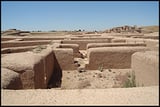Incest and Ritual Sacrifice: Shocking DNA Findings at Ancient Mexican Site Paquimé
August 13, 2024
Excavations at Paquimé have uncovered various layers of human remains and artifacts, revealing insights into the health and social practices of its inhabitants.
Recent DNA analysis of a child burial at the archaeological site of Paquimé in Mexico has revealed that the child's parents were likely very closely related, possibly siblings, suggesting a practice of close relative mating among elites for ritual sacrifice.
The study, led by Dr. Jakob Sedig from Harvard and published in the journal Antiquities, found that the child's DNA exhibited a high number of identical genes, indicating a level of consanguinity closer than first cousins.
Notably, the analysis indicated one of the highest recorded 'runs of homozygosity' values in ancient individuals from the Western Hemisphere, further supporting the idea of close familial relationships.
The child was buried in the 'House of the Well,' a significant ceremonial structure reserved for local elites, highlighting the cultural importance of the child's sacrifice in enhancing the family's status.
Previous studies suggest that this child was a victim of human sacrifice, viewed by elites as a powerful act to consecrate important buildings.
These findings contribute valuable insights into the social structures, practices, and population dynamics of ancient Paquimé, indicating that elite families may have engaged in incestuous unions to consolidate their power.
Dr. Sedig emphasized the ongoing mystery surrounding the social hierarchy and biological relationships of Paquimé's inhabitants, as scholars continue to debate the site's social organization.
The origins and decline of Paquimé remain subjects of scholarly debate, with theories suggesting influences from various regional cultures and potential violent or disease-related factors contributing to its abandonment.
Paquimé, also known as Casas Grandes, served as a multicultural center during the 13th and 14th centuries AD, situated between Mesoamerican and Ancestral Puebloan groups.
Despite its significance as a political and ritual center of the Mogollon culture, much about the site's genetic makeup and social structure remains unknown.
The child, believed to have been sacrificed in the fourteenth century, was found in a burial context that underscores the complex social dynamics of the time.
Summary based on 4 sources
Get a daily email with more Science stories
Sources

Nature • Aug 13, 2024
DNA of child sacrificed in ancient city reveals surprising parentage
Gizmodo • Aug 12, 2024
Ancient Mexican Child Sacrifice Linked to Elite Inbreeding
Cambridge Core • Aug 13, 2024
High levels of consanguinity in a child from Paquimé, Chihuahua, Mexico | Antiquity | Cambridge Core